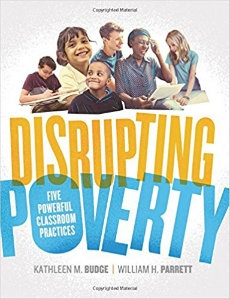Disrupting Poverty: Five Powerful Practices
Disrupting Poverty: Five Powerful Classroom Practices
By Kathleen M Budge and William H Parrett
(ASCD, 2018 – Learn more)

I work in a very diverse middle school as a reading specialist. Most of the students I interact with come from poverty stricken homes.This is not the first book that I have read about poverty and children who have grown up in poverty and how to teach them, but Disrupting Poverty: Five Powerful Classroom Practices is the easiest to understand and contains very impactful strategies to use in the classroom.

Begin with a self-inventory
The beginning of this book contains the background information which explains what poverty is and more importantly what it is not. It contains a reader self-inventory that can help us determine whether we have our own misconceptions. Budge and Parrett explain the facts and ways to help teachers work with students who live with poverty.
The authors ask three questions throughout the book:
1. Who? (What do we bring to the topic? How do we feel about the topic?)
2. What? (What does research say about this topic?)
3. How? (How do others deal with this topic?)
Who is the self that teaches? How does the quality of my selfhood form—or deform—the way I relate to my students, my subject, my colleagues, my world?” (The Courage to Teach, 2007)
They also encourage readers to write a 100-word reflection in response to this prompt: How do you feel when students don’t learn what you teach them? What do you do when this happens?
The elements of disrupting poverty
The second part of this wonderful text are the five ways to disrupt poverty. Each chapter delves deep into one component for disrupting poverty by answering the three questions (who, what and how) and by providing research-tested practices to implement in your classroom.
I like to compare this part of the book to the recipe section: if we put all the ingredients together, we will make something wonderful. The following are the five ways to disrupt poverty:
1. Build Caring Relationships. This is not new, but teachers are given a new model to follow called Models, Mentors, Interveners and Extended Family. Make every day count with your students because each day you show up for them matters.
2. Have High Expectations with Support. The 4 C’s: caring, clear, consistent, communication of expectations.
3. Commitment to Equity. Meet your students where they are and build them up.
4. Professional Accountability for Learning. I think this is one of my favorite sections because it calls on my professionalism. I alone am responsible for this aspect – either I am willing to learn, unlearn and relearn what I need for my struggling students or I am not. The choice is ours. There is an in-depth chart called “10 Effective Practices for Developing a Pedagogy of Possibility.” It is chock-full of information and ideas to mull over and say “yes I do this,” or “no, I need more information.”
5. Courage and Will to Take Action. Are you a caring teacher with mutual respect for your students? Do you have and maintain high standards for all of your students? Do you differentiate instruction to make learning available to all of your students? Do you go back to the drawing board if the students just don’t get it?
If you can answer YES to these questions, then you have what it takes to disrupt the poverty in your classroom and help make your students successful no matter their circumstances.
Putting ideas into classroom actions
This book has helped me rethink my own ideas of how to work with students who live in poverty. I am encouraged by the new research and practices that are simple and straightforward to use with all students so they can experience success in their education. I appreciated the ease with which you can begin using these strategies in your classroom.
I have shared this book with my 6th grade team, and we are starting a team effort to disrupt poverty one grade, one classroom, one student at a time. It is a very worthwhile read if you teach in a high poverty, low performing school. I wish strength and perseverance to all educators who dare to disrupt poverty in their schools.
Visit the study guide for Disrupting Poverty to learn more about this book.
Lisa Signorelli has been involved in education since 1985. She earned her master’s degree in reading education in 1989. She has held many teaching positions in both New York and Virginia. She’s taught all grades from kindergarten through twelfth grade. Her current position is as a reading specialist/literacy coach at a low performing middle school. She is an avid reader of both young adult literature and educational pedagogy. Her goal is to have a book in every student’s hand by the end of the school year that they can call their own.


































